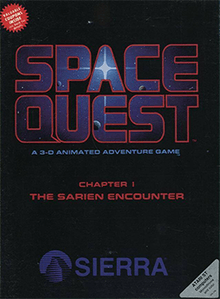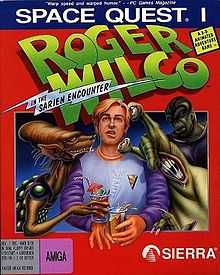Space Quest I
| Space Quest: Chapter I - The Sarien Encounter | |
|---|---|
 Atari ST cover art | |
| Developer(s) | Sierra |
| Publisher(s) | Sierra |
| Designer(s) | Mark Crowe and Scott Murphy |
| Series | Space Quest |
| Engine | AGI |
| Platform(s) | DOS, Macintosh, Apple II, Apple IIGS, Amiga, Atari ST |
| Release date(s) | October 1986[1] |
| Genre(s) | Adventure |
| Mode(s) | Single-player |
| Distribution | 3.5" Floppy Disk or 5.25" Floppy Disk |
Space Quest: Chapter I – The Sarien Encounter (aka Space Quest I) is a video game released in October 1986.[1] It is the first game in the Space Quest series. It quickly became a hit, selling in excess of 100,000 copies. Total sales are believed to be around 200,000 to date, not including the many compilations it has been included in.
Space Quest was the brainchild of Sierra programmers Scott Murphy and Mark Crowe, who had worked on prior titles like King's Quest II, but had not designed their own game yet. According to Murphy, "At that time (1985), everything at Sierra was so somber and had an almost medieval atmosphere. So we decided 'Why not make a fun, silly game?'"
Plot
Players of the original game are never told the hero's name, but are instead asked to enter their own. The default name of "Roger Wilco" — a reference to the abbreviated radio communication, "Roger, Will Comply" — became the de facto name of the hero in the later games of the series.
Roger is a member of the cleaning crew on board the scientific spaceship Arcada, which holds a powerful experimental device called the "Star Generator" (a thinly-veiled reference to the Genesis Device from Star Trek II). Roger emerges from an on-duty nap in a broom closet to find that the ship has been boarded and seized by the sinister Sariens. Using a keycard that he found from the body of a dead crew member, he finds his way to an escape pod and escapes the Arcada.
After crash-landing, he finds himself in the dry and barren wasteland of the planet Kerona. After making his way through the desert and a system of underground caves, he is tasked by an insectoid alien with killing a monstrous creature called Orat. After succeeding in this task, he returns to the alien with proof of his success in the form of a piece of Orat's flesh. As a reward, the alien lets him into an underground complex inhabited by more aliens, and provides Roger with a skimmer, a small flying vehicle which cruises a few feet over the sandy ground (similar to the landspeeders in Star Wars).
The alien tells Roger there is a town that he may travel to in order to find a way off the planet. After navigating a rocky section of the planet, Roger reaches the town of Ulence Flats and goes to the local bar. By playing a video slot machine, Roger wins enough money to buy a spaceship and a navigation droid.
He overhears from a bar customer the location of the Sariens' spaceship, the Deltaur, and flies to its coordinates. He then infiltrates the ship by, but not limited to, utilizing his jetpack, dodging a droid, climbing inside an air vent, locking himself in a trunk, getting put inside a washing machine, disguising himself as a Sarien by wearing one of the Sarien uniforms, and other tactful, creative methods. He then finds his way to the Star Generator and programs it to self-destruct, escaping the ship just before it explodes.
At the end of the game, Roger's efforts are rewarded when he receives the Golden Mop as a token of eternal gratitude from the people of Xenon.
Gameplay
The game was programmed using Sierra's AGI engine and featured a pseudo-3D environment, allowing the character to move in front of and behind background objects. The primary means of input in Space Quest, as in many other AGI games, was through the use of a text parser for entering commands and use of the keypad or arrow keys for moving Roger Wilco around the screen. The Amiga, Apple IIGS, Atari ST and Mac versions of the game offered basic mouse support for movement as well. The game had a 160×200 resolution displaying 16 colors. Sound cards were not available in 1986, so sound was played through the PC's internal speaker; owners of Tandy 1000, PCjr and Amiga computers would hear a three-voice soundtrack, while Apple IIGS owners were treated to a fifteen-voice soundtrack with notably richer sound.
A precursor of this game is the interactive fiction game Planetfall, created by Infocom, whose player-character is a lowly "Ensign Seventh Class" who does the lowest form of labor aboard a spaceship and who appears on the cover with a mop. Just as King's Quest adapted the text-adventure puzzle games set in a medieval world to a visual display, Space Quest did the same for the space puzzle game.
As a form of copy protection, coordinates in the game while in the escape pod as well as the rocket purchased at Tiny's Used Spaceships are only found in the manual. Also, the code for retrieving the cartridge aboard the Deltaur can only be found in the manual.
In addition to this, the AGI version had key disk protection where the user was required to insert the original game floppy on startup.
Sierra released three versions of Space Quest: the original 1986 AGI V2 release, the 1987 AGI V3 release, and the 1990 VGA release. Aside from minor sound/graphics differences, the PC, Amiga, Atari ST, and Apple IIgs versions are largely identical. The Mac version is considerably different due to being monochrome and completely menu-driven. In addition, Space Quest had an 8-bit Apple II version for the //e and IIc. This had no pull down menus and displayed all text at the bottom of the screen.
Along with King's Quest III, Space Quest was the first Sierra game to feature pull down menus, be hard disk installable, and not require a specially formatted save disk (except the Apple II version as noted above).
Reception
Compute! praised the Apple IIGS version's sound and graphics, stating that players "may think they're watching a cartoon". It concluded that the game "is one of the better new adventure games to arrive".[2]
Controversy
Toys R Us sued Sierra for its use of the name Droids R Us without their permission. The store was changed to Droids B Us. Despite this, the remake adds a parody of Geoffrey Giraffe, the store's mascot, along with a design very resemblant of the store.
ZZ Top sued Sierra for putting a band resembling them in the game without permission. Despite this, they re-appear in certain versions of the VGA remake.[3]
Remake
| Space Quest I: Roger Wilco in The Sarien Encounter | |
|---|---|
 | |
| Developer(s) | Sierra |
| Publisher(s) | Sierra |
| Designer(s) | Mark Crowe and Scott Murphy |
| Engine | SCI1 |
| Platform(s) | DOS, Macintosh, Amiga |
| Release date(s) | August 20, 1991 |
| Genre(s) | Adventure |
| Mode(s) | Single-player |
| Distribution | 3.5" Floppy Disk or 5.25" Floppy Disk |
Space Quest was eventually remade using Sierra's newer SCI language, which allowed the game to upgrade from its original EGA graphics to VGA. Rebranded to Space Quest I: Roger Wilco in The Sarien Encounter to follow the new series naming convention introduced with Space Quest IV, this version was released on August 20, 1991; in addition to the new VGA graphics, which were drawn in 50's retrofuturistic B-movie style, it now featured digitized sounds. The game's interface was also changed, with text-entry being replaced by a standard icon interface which would be used by many SCI games.
The VGA remake also featured the taste and smell icons, which would reappear in Space Quest IV. These icons are not used to solve any puzzles; instead, they merely serve as comic fodder for the game's humor.
When leaving Ulence Flats in the VGA version, the time pod from Space Quest IV appears. Space Quest IV was developed around the same time. However, a continuity error occurs, as the time pod appears in a different place than in Space Quest IV.
Comics
Adventure Comics released three issues in 1992 of a comic based on Space Quest under the name The Adventures of Roger Wilco. The first was written by John Shaw and was in full color. The other two were written by Paul O'Connor and were black and white. The print run was very small and the books are very rare.
Reception
The 1991 remake of the game was reviewed in Dragon, receiving 5 out of 5 stars.[4]
References
- ↑ 1.0 1.1 Weston, D.B. Greatest Moments in Video Game History. p. 52. ISBN 978-1301174140.
- ↑ Thomas, Scott (August 1988). "Space Quest—The Sarien Encounter". Compute!. p. 70. Retrieved 10 November 2013.
- ↑ "Space Quest 1 Cameo Appearances". SpaceQuest.Net. Retrieved 2012-08-27.
- ↑ Lesser, Hartley; Lesser, Patricia & Lesser, Kirk (January 1992). "The Role of Computers". Dragon (177): 57–66.
External links
- Space Quest I: Chapter I – The Sarien Encounter at MobyGames
- Space Quest I: Roger Wilco in the Sarien Encounter at MobyGames
| ||||||||||
| ||||||||||||||||||||||||||||||||||||||||||||||||||||||||||||||||||||||||||||||||||||||||||||||||||||||||||||||||||||||||||||||||||||||||||||||||